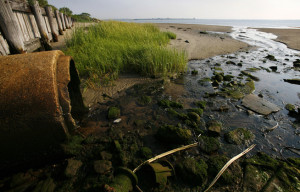 O’Malley environmental record is big on posturing while Maryland’s biggest pollution problem, government water treatment, continues to dump millions of gallons of raw sewage into the bay.
O’Malley environmental record is big on posturing while Maryland’s biggest pollution problem, government water treatment, continues to dump millions of gallons of raw sewage into the bay.
by Mark Uncapher, Montgomery County Republican Chairman
Recently Governor O’Malley unveiled his Maryland climate change initiative with the objective to reduce carbon emissions by 25%. If press releases, speeches and grandiose promises alone were enough produce a cleaner environment, then the Governor would certainly qualify as an environmentalist.
Unfortunately, the raw sewage that continues to pour into Baltimore Harbor tells a different story about O’Malley’s environmental record.
Eleven years ago then Mayor O’Malley settled a lawsuit by the EPA against Baltimore City. The EPA charged the City with illegally dumping over many years some 110 million gallons of wastewater containing raw sewage from city’s sewer system, resulting “elevated levels of coliform bacteria.” As the EPA complaint dryly noted, “Organisms in untreated wastewater containing raw sewage can cause a number of diseases in users of contaminated areas. These diseases include, but are not limited to, enteric diseases such as gastroenteritis, dysentery, and cholera. These diseases are highly communicable.”
So rather than face fines and further legal action, O’Malley signed a consent agreement on behalf of the City promising to address the problems, including making the necessary investment upgrades by 2016 to fix the sewer system and prevent further illegal discharges. At the time, fourteen years probably seemed a very generous timetable.
How is the city doing? Despite initially committing to spend an estimated billion dollars on clean-up investments, after a decade the city has spent about $500 million. Most of this spending has been limited to the analysis phase and design of a new system. So while O’Malley was Mayor for the first five years of the consent period, the record shows he utterly failed to create the necessary capital investment pipeline to address his city’s single most important environmental challenge.
Worse, Baltimore admits that between 2010 and 2012 it discharged than 7 million gallons of raw sewage directly into Baltimore’s streams and harbor. According to advocates, this number does not include millions of additional gallons of sewage spills from stormwater outfalls and does not include sewage overflows that went undetected by the City.
Only three more years remain before the 2016 deadline of the original consent decree and Baltimore will not be ready. According to the Baltimore media, the city is negotiating with the EPA to extend the ultimate deadline of the consent decree from 2016 to 2019 and beyond.
In preparation for O’Malley’s Presidential run, his handlers should refresh their collective memories with this 1988 Bush commercial highlighting Michael Dukakis’ Boston Harbor failures. (See: http://www.livingroomcandidate.org/commercials/1988/harbor )
That was then. Twenty-five years later, after significant clean-up investments, the EPA calls the Boston Harbor a “great American jewel.” Harbor seals and porpoises are now common sights in the water. Baltimore and the entire Chesapeake region could have benefited from the same resolve.
Instead contrast Boston’s success with O’Malley own most recent “harbor initiative.”
Earlier this summer the Baltimore Sun reported that the Governor intervened with the EPA to seek a waiver for cruise ships operating out of Baltimore. Cruise ships burn an especially dirty fuel with 1,800 times more sulphur than permitted in buses and trucks. At sea, a single vessel produces as much air pollution, daily, as 12,000 autos. So the EPA is cracking down on cruise lines to save an estimated 5,500 to 14,000 premature deaths and $100 billion in health care costs by 2020. When sailing within a so-called “emission control areas” (i.e., near land), cruise ships would be required to burn cleaner, but more expensive, fuel. Yet the Governor’s office admitted to the Sun that O’Malley had spoken twice with the acting EPA administrator while lobbying for cruise line efforts to obtain a waiver from the agency’s cleaner-fuel mandate.
The Gazette’s Blair Lee put it best, when he asked “Could someone please explain why Gov. Martin O’Malley is going to bat for one of Maryland’s worst polluters? Our governor touts himself as the green governor, cracking down on pollution and sprawl regardless of the economic consequences. His septic tank ban, stormwater management standards and Plan Maryland restrictions on development outside public water and sewer districts is a gut shot to Maryland’s homebuilding industry. His moratorium on natural gas mining (fracking) denies jobs, revenue and a much-needed economic boost to Western Maryland while fracking rejuvenates economies elsewhere without serious environmental damage.”
Democratic presidential primary voters (and others) take note, when it comes to the environment, Martin O’Malley talks the talk, but fails to follow through.
